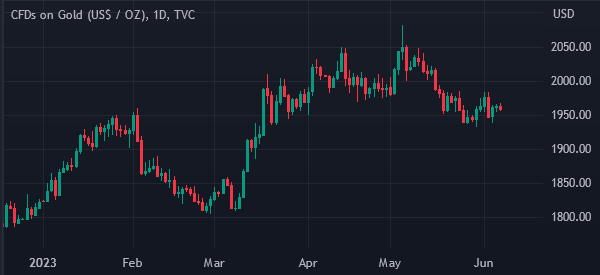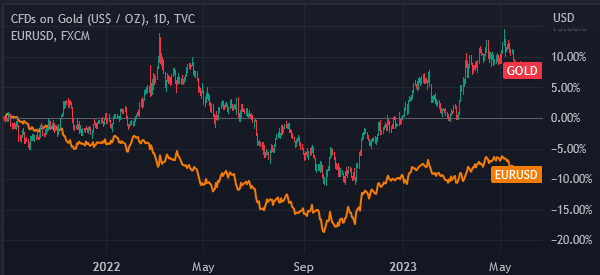Since time in memorial, gold has played an important role in the financial market. It has been synonymous with luxury and power. In the past, it used to make religious idols, honor monarchs and serve as currency. In the United States, the dollar was pegged to gold until 1971 when this peg was removed.
To date, the Federal Reserve and other central banks around the world hold huge deposits of gold for emergency purposes.
-After the great depression, the Roosevelt administration fixed the price of gold at $35/ounce. This was removed by the Nixon administration in 1971 leading to a 2,200% gain in its price, resting at $800 before going down to $260 in 1999.
After this fall, gold began a bull run and is today trading at $1,136. These fluctuations are very important for traders who can make a lot of money in the process.
In this article, We will explain a few strategies to help you trade gold spot prices.

Table of Contents
Day Trading Strategies for Trading Gold
Fundamental and intermarket factors
As a commodity, gold prices depend on a number of factors such as supply and demand. In addition, monetary and fiscal decisions play an important role in pricing gold. In a strong economy, there is increased confidence for investors to buy gold. As a result, the price keeps on going up.
The better the returns in the bond and stocks market leads to higher returns in gold prices. Historically, a strong dollar leads to strong gold and vice versa.
As a day trader, you need to have a holistic approach about the fundamentals so that you can know when to enter and exit a trade.

Technical strategies for gold trading
For day traders, price movements are key to make sweet returns in gold trading. In many cases, gold will follow a certain trend. Therefore, it is your responsibility as a trader to find the trend and enter a position.
To identify a trend, trend analysis is very important. Luckily, there are tools (indicators) which can help you in this. For short term trades, you simply want to identify the support and resistance levels.
Trendlines also play a very significant role in confirming other technical indicators such as those generated by MACD and Relative Strength Index (RSI).
In our experience, we have identified the best strategy as one where we wait for the trendline to be breached before we make our entry position. To create an upward trend, the best strategy is to connect a series of rising bottoms and find a support opportunity. On the other hand, a downward trend is created by joining a series of highs.
Another technical strategy to use is that of moving averages because they are simple to use and easy to generate. The best buying position is when the shorter term, faster moving average passes above the slower one. Also, you can sell when the faster average crosses below the slower average in a trending market.
To execute this strategy in the best way, you need to first understand the type of market, whether it is a trending market or a range bound market. Other trend analysis indicators you can use include:
Identifying a divergence is also very important. A good indicator to help you in this is the Relative Strength Index (RSI). Quite often, the RSI will hit highs and lows as the gold price turns either down or upwards.
To place a trade, you should always try to find a confirmation of the divergence. Confirmation leads to an increase in confidence. With increased confidence, the result will be a better trade.
→ A Brief Guide on Technical Analysis and the Tools You Can Use
Copy trading
Another gold trading strategy is known as copy trading. It is a solution offered by many brokers that lets people copy trades from other experienced professionals.
The process of doing this is very simple. First, you create an account with a broker that offers these solutions.
Second, you look at the best gold traders in the ecosystem and then decide to copy them. After doing this, all their trades will be mirrored to your account. As part of this process, the master trader will take a small commission for all profitable trades.
Ways to trade gold
There are several approaches to trade gold. First, you can trade gold contracts for difference (CFD). A CFD is a financial derivative that allows you to buy or sell gold and profit with its price movement. These products are not offered in the United States.
Second, you can trade gold options and futures. An option is a derivative that gives you a right but not an obligation to buy an item for a certain price at a certain date. Futures, on the other hand, give you the obligation to buy the asset.
Third, you can trade gold ETFs. An ETF is a financial product that tracks the price of an asset. The benefit of these funds is that they can be traded in a similar way to stocks. Examples of the most popular gold ETFs are iShares Gold Trust and SPDR Gold Shares.
Finally, you can trade gold mining stocks like Barrick Gold and Newmont Mining. The idea is that these stocks have a correlation with gold.
Key movers of gold
There are several things that move gold prices. First, like all metals, gold price is affected by supply and demand. Its price tends to rise when there are supply disruptions in key countries. It also rises when there are huge institutional and central bank purchases.
Second, the biggest catalyst for gold prices is the action of the Federal Reserve. The price tends to do well when the Fed is in a dovish tone and vice versa. For example, gold surged to over $2,000 for the first time during the Covid-19 pandemic when the Fed slashed interest rates.
Third, it is moved by key American economic data. The most popular numbers that move gold prices are inflation, jobs, manufacturing production, and consumer confidence. These numbers are important because they have an impact on the Fed.
Inflation is an important number since gold is often seen as a hedge against inflation. Therefore, in most cases, it rises in a period of high inflation.
5 Tips to improve your Gold Trading strategies
Ok, You are now familiar with the best ways to trade gold. However, there are other tips you can follow to further improve your ability to generate profits from the blond metal.
1 – Read about Gold
The first thing you need to do is to read about gold (here a selection of day trading books). You should read about the various aspects of gold such as its history, the main exporters and importers of gold, and its use. You should also read how gold relates to other asset classes such as bonds, currencies, and stocks.
There are many books on gold investing that you can read. Some of the best books on gold are: Barry Eichengreen’s Golden Fetters, Peter Bernstein’s The Power of Gold, and James Rickards’ The death of money.
These books will give you a boost on the fundamental information you need to understand gold and how it works. You also need to always have the latest information with you as soon as it breaks.
A few tools that might help you with this are: Bloomberg (TV, Twitter, and their website), Wall Street Journal, CNBC, and StockTwits among others. You should adjust your trades as soon as news relating to gold breaks.
2 – Relationships
We spoiled this point above. You should carefully identify the relationships between gold and other asset classes.
Gold relates in a certain way between the major asset classes. For instance, gold tends to go up during periods of high uncertainties. It also tends to go up when the dollar weakens and when the US market is going down.
The logic behind this is simple: as the market goes up, investors try to find opportunities to make money in the stock. They mobilize their resources from gold to buy stocks. In addition, when the dollar is losing its value, investors will buy gold as a way of mitigating risks.
Therefore, you should take time to understand these relationships and how they work.
3 – Develop a Strategy
After learning and understanding how gold trading works, you should now take time to develop a strategy. This should guide you on when to buy, hold, or short gold. The strategy can either be technical or fundamental, as we were above. You can also combine the two analysis methods to create a trading strategy.
The strategy can be manual or automatic. In a manual trading strategy, you will take time to look at your charts until a time when your parameters are met. You will then open a trade when all the parameters are met.
An automatic strategy is one where algorithms execute the trades when the parameters are met. You should always back-test the strategies to ensure that it’s accurate.
4 – Back-Test the Strategy
After developing the strategy, you should now back-test it to ensure that it’s accurate. While no strategy is 100% accurate or risk-free, your strategy should have a high accuracy level. In this, you should do the best you can to create various models and backtest the tool with it.
This process should take a period of between a month or two. Also, you should use only a few tools to create the system. The more tools you use, the tougher it will be for you to become successful.
The Bottom-line
To make sweet returns in trading gold, you need to understand the key factors that lead to price movements. In addition, having a good understanding about the economy will help you make confident results.
After understanding the macro conditions, you should now focus on technical analysis.
By understanding the trend, and knowing how to identify the divergence, you will be in a good position to make good entry and exit decisions.
Other useful resources in gold trading
- Simple gold trading strategies – Trading Strategy Guides





